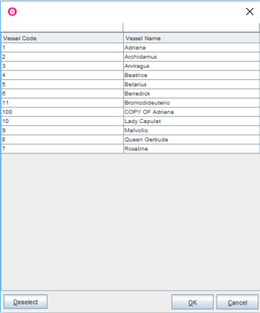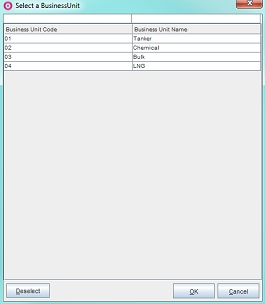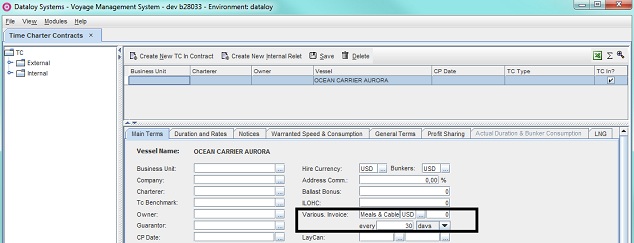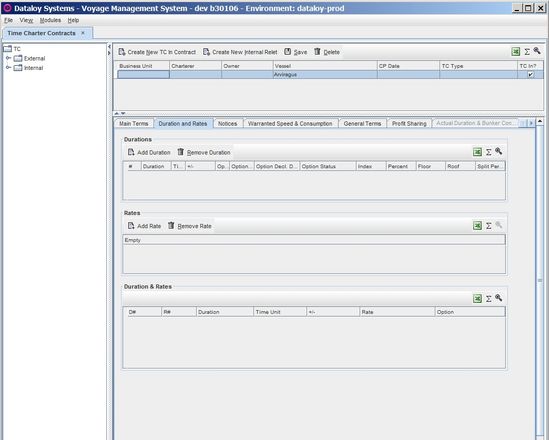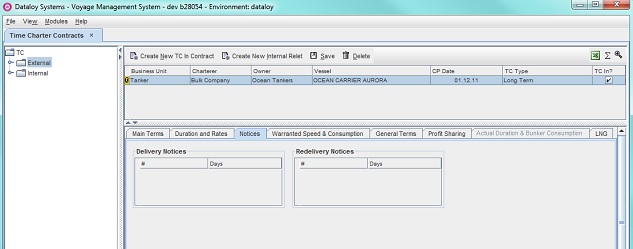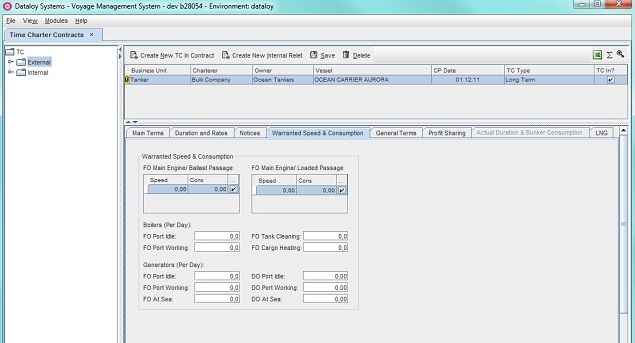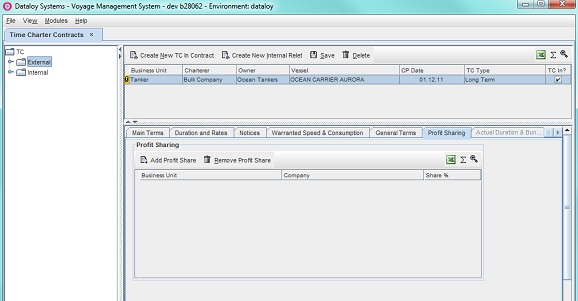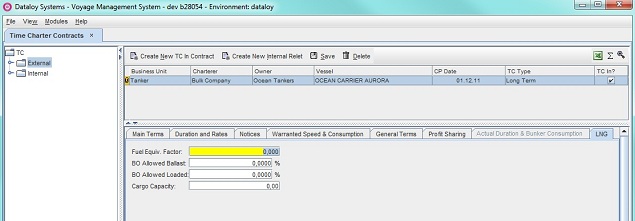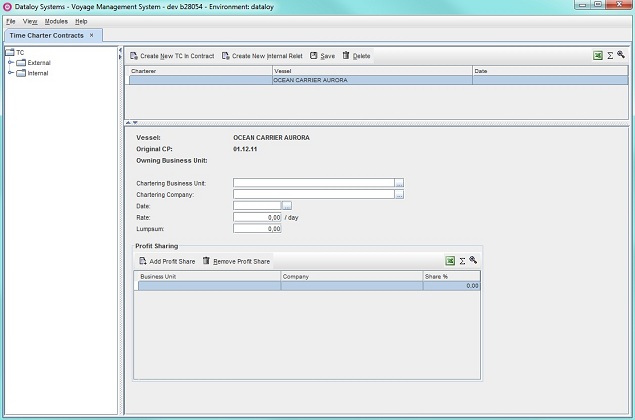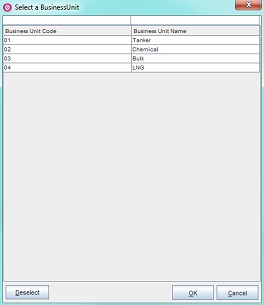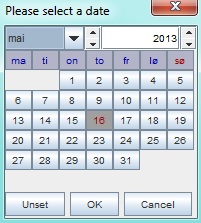Time Charter Contracts
Short Description
The Time Charter Contracts module is where all agreed in detail and finalised time charter (TC) contracts, both in and out, external and internal, are registered, maintained and archived. Once a TC contract is entered, the module serves as a reference base as the contract can be easily accessed either directly through the module or indirectly through the Voyage Estimate and Booking and Operations modules.
A Time Charter (TC) Contract can be either In or Out, Internal or External. An internal contract is an in-house contract between business units, for example internal relets. Invoices are then handled through Internal Allocations. An external contract is a contract between business partners and invoices are handled through the Accounts Payable/Accounts Receivable/Hire Payable modules.
A TC In Contract can be defined as a contract of hire of a vessel for a specified period of time, whilst a TC Out Contract handles the letting of a vessel for a particular time period. Under both, the Charterer will decide route and ports, pay a daily hire, all port charges and fuel consumption whilst the Vessel Owner remains in control of the vessel.
Each contract will include agreed terms and conditions, for example duration and rate/s, option/s, profit sharing, deliver/redelivery terms, invoice parameters, etc. If a contract entry is supplemented with an attachment of for example a scanned Charter Party (CP), its full details will be directly accessible in the system. Invoices will be generated towards either the charterer (TC Out, Accounts Receivable) or the owner (TC In, Hire Payable). Note: Under each TC contract, one or more of the duration options may be optional. If the optional durations are entered and separated incorrectly in the Duration and Rates section, the TC contract will not reflect terms accurately. To correct: reduce the firm durations and add one or multiple options reflecting the true structure of the contract. Also when monthly rates are converted into days the rate will ONLY be approximately correct as months vary in lenthg.
Only TC In Contracts are entered and saved directly into the Time Charter Contracts module. TC Out Contracts are automatically saved and archived in the module but created through the Voyage Estimate.
Utilising the Time Charter Contracts module further enables the automatic calculation of TC hire (cost) for each performed voyage during vessel hire, the keeping track of all invoices and statements towards an owner (Hire Payable) and forecasting future results and budgeted vessel costs through various reports and in the Positions Dashboard. However, it is currently not possible to copy an existing Time Charter Contract and use it as base to create a new.
Location: Modules > Contract Management > Time Charter Contracts
Chapters:
Long Description
Enter a Time Charter (TC) In Contract
- Go to
Modules > Contracts Management > Time Charter Contracts.The Time Charter Contracts window opens. Click Create New TC In Contract. A separate pop-up opens.
Example:
- Select a vessel to create a time charter (TC) in for and click OK.
- The pop-up will close and the vessel appears in the left-hand menu tree and to the right, its fields will display.
Example: - In the Main Terms tab, fill in the fields as follows:
- Enter either:
- the name of the business unit entering into the TC (i.e. "owns" it internally) under Business Unit
- or click the Triple Dot Selector next to the field. A pop-up with a list of input values opens. Select field and click OK.
Example:
- Enter the name of the legal entity entering into the TC contract (i.e. signs the contract) under Company.
- Enter the business partner representing the Company (company, see above) under Charterer.
- Enter the index against which voyages performed under a TC will be measured (or benchmarked) under TC Benchmark and the TC benchmark percentage under %.
- Enter the name of the vessel owner under Owner.
- Enter the business partner/s that sets a guarantee for the TC under Guarantor.
- Enter either
- the charter party (CP) date under CP Date
- or click the Triple Dot Selector next to the field. A pop-up with a calendar opens. Select date and click OK.
- Enter the time charter type under TC Type.
- Enter the charter party (CP) form for the TC contract under CP Form.
- Enter the name of the person responsible for operating the vessels under the TC contract under Vessel Operator.
- Enter the name of the person responsible for the TC contract in the Chartering department under Charterer.
- In the top right fields:
- Enter the currency to be used for the TC under Hire Currency.
Note: Defaults to USD. - Enter the currency to be used for bunkers under Bunkers.
Note: Defaults to USD. - Enter the address commission under Address Commission.
- Enter the agreed ballast bonus lumpsum (if applicable) under Ballast Bonus.
- Enter the agreed ILOHC lumpsum (if applicable) under ILOHC (In Lieu of Holds Cleaning).
Note: Only one ILOHC lumpsum can be entered into the contract. - In the Various Invoice fields:
- Enter the name for collected crew costs in the initial field.
Note: Defaults to Meals & Cables, also called C/V/E (Communication/Victuals/Entertainment) - Enter applicable currency for the Various Invoice cost in the second field.
Note: Defaults to USD. - Enter the agreed anount for the Various Invoice cost in the third field.
- Enter the interval number for Various Invoice cost payments and from the drop-down menu select if the payment cycle is in days or months.
- Enter the name for collected crew costs in the initial field.
- In the LayCan fields:
- Enter the start date for lay/can spread in the initial field.
- Enter the end date for lay/can spread under second field.
- Enter comments (if applicable) under Comments (textbox).
- Enter the currency to be used for the TC under Hire Currency.
- In the Delivery Terms panel:
- Enter the delivery port under Delivery Port.
- Enter the terms of delivery under Terms.
- Enter the delivery range (if applicable) under Delivery Range.
Example:
A range between two ports (e.g. Oslo - Bergen), worldwide, etc. - Enter the delivery date under Delivery Date.
- In the Bunkers on Delivery fields enter (as applicable):
- Under FO:
- the agreed amount of fuel oil (FO) onboard at the time of delivery in the first field.
- the agreed purchase price of the onboard FO at the time of delivery in the second field.
- Under DO:
- the agreed amount of diesel oil (DO) onboard at the time of delivery in the first field.
- the agreed purchase price of the onboard DO at the time of delivery in the second field.
- Under FO (Low Sulphur)
- the agreed amount of fuel oil low sulphur (FO LS) onboard at the time of delivery in the first field.
- the agreed purchase price of the onboard FO LS at the time of delivery in the second field.
- Under DO (Low Sulphur)
- the agreed amount of diesel oil low sulphur (DO LS) onboard at the time of delivery in the first field.
- the agreed purchase price of the onboard DO LS at the time of delivery in the second field.
- Under FO:
- In the Redelivery Terms panel:
- Enter the redelivery port under Redelivery Port (RED marking = required field).
- Enter the terms of redelivery under Terms.
- Enter the redelivery range (if applicable) under Delivery Range.
Example: A range between two ports (e.g. Oslo - Bergen), worldwide, etc. - Enter the redelivery date under Redelivery Date.
- In the Bunkers on Redelivery fields enter (as applicable):
Note: If index based - leave blank until just before redelivery. Return and update the contract with correct figures as currently Dataloy VMS cannot indicate if amounts are index based - only the actual.- Under FO:
- the agreed amount of fuel oil (FO) onboard at the time of redelivery in the first field.
- the agreed purchase price of the onboard FO at the time of redelivery in the second field.
- Under DO:
- the agreed amount of diesel oil (DO) onboard at the time of redelivery in the first field.
- the agreed purchase price of the onboard DO at the time of redelivery in the second field.
- Under FO (Low Sulphur):
- the agreed amount of fuel oil low sulphur (FO LS) onboard at the time of redelivery in the first field.
- the agreed purchase price of the onboard FO LS at the time of redelivery in the second field.
- Under DO (Low Sulphur):
- the agreed amount of diesel oil low sulphur (DO LS) onboard at the time of redelivery in the first field.
- the agreed purchase price of the onboard DO LS at the of time redelivery in the second field.
- Under FO:
- In the Invoice Parameters panel:
- Enter the interval number for invoice payments and from the drop-down menu select if the payment cycle is in days or months.
Note: The interval number always displays with five decimals.
Example: - Select if the payment cycle is in days or months.
Note: By deafult the payment cycle is in days and the Invoices Follow Calendar Month checkbox deactivated. Selecting Months from the drop-down will activate the checkbox. It will by default be checked. If checked, an invoice must be generated from the delivery date up to the start of the next month. From then on, the system will automatically follow calendar months. - Enter applicable invoice timezone - GMT or LT (Local Time) - under Invoice Timezones.
Note: Defaults to GMT (Greenwich Mean Time) - Recommended. This will avoid the need for recalculation to obtain the accurate time duration of a voyage when invoicing. - Enter the the default owner's bank account number under Default Owner's Bank Account.
- Check Consumption Based Bunkers to indicate that the Charterer will not purchase bunkers, only pay for the consumption.
Note: If checked the Bunkers on Delivery and Bunkers on Redelivery are rendered invalid. However, the entered price data in the Bunkers on Delivery section will be used to calculate the price of consumed bunkers. The ROB on Delivery (bunkers remaining on board on delivery) is used as estimated consumption until the actual is known. Check Revaluate Bunker's CP Price to indicate that bunkers should not be re-evalueted upon delivery (only applicable when activated).
Note: This field is only activated if bunker consumption is not selected. For time charter out - always disabled.
- Enter the interval number for invoice payments and from the drop-down menu select if the payment cycle is in days or months.
- In the Commissions panel:
- Add a Broker with Commission:
- Move the cursor to the Commissions field.
- Right-click. A menu opens.
- Select New. The menu will close and a row displays in the Commissions field.
- Enter the broker under Broker.
- Enter broker contact name under Contact.
- Enter the commission percentage under Percent.
- Enter the commission rate under Rate.
Note: The rate is per day - it is rarely used. - Enter applicable lumpsum under Lumpsum (if any).
- Enter the Commission under Commission.
- Check Credit Owner to indicate that the Owner will pay the commission to the broker.
Note: For Time Charter Out - change of function: Credit Charterer. Check Credit Charterer to indicate that the Charterer will pay the commission to the broker. - Check Charterer's Cost to toggle the commission between Owner and Charterer.
Note: Checked box indicates that the Charterer is to bear to cost of the commissions payable to brokers instead of the Owner. Post Fixture modules processes this type of commission invoices. - Check C/O (care/of) to indicate that invoices should be sent through the broker.
- Remove a Broker with Commission:
- Click the broker commission row to be deleted - it will highlight.
- Right-click and from the menu select Remove.
- The menu will close and the selected row delete.
- Add a Broker with Commission:
- Enter either:
- Click Save. The row in the upper right-hand field populates with additional newly entered data aside from the vessel name and the TC In Contract appears in the left-hand menu tree both under View by Business Partner and View by Vessel (Charter In folder) in the External folder.
Example: - Click the Duration and Rates tab. The Duration and Rates tab fields displays.
- Add Durations and Rates:
- Click Add Duration in the Duration panel. A row displays.
Note: Duration refers to a time period a vessel is chartered under a TC contract. A duration can have one or more rates and each added duration is numbered in sequential order. The first entered duration is therefore labelled 1, the second 2, etc. - Fill in the row as follows:
- Enter the time unit to be used under Time Unit.
Note: Either M = Month, D=Days. Months vary in length and when converted to days will then ONLY be approximately correct. - Enter the +/- time available to reach set destination at agreed time under +/-.
- Enter agreed option (if applicable) under Option.
- Enter agreed option declaration (if applicable) unber Option Declaration.
- Enter the date if the Option Declatation (as applicable).
- Enter option status (if applicable) under Option Status.
- Enter index under Index.
- Enter index percent under Percent
- Enter floor limit under Floor.
- Enter roof limit under Roof.
- Enter the split percent (if applicable) under Split Percent.
- Enter the time unit to be used under Time Unit.
- Click Add Rate in the Rates panel. A row displays both in the Rates and in the Duration & Rates sections.
- In the Rates panel, click each respective row field (except the # field) and as applicable:
Note: Each added rate is numbered in sequential order. The first entered rate will therefore be labeled 1, the second 2, etc.- Enter the rate duration under Duration.
Note: The rate duration will always display with five decimals. - Enter the rate under Rate.
- Enter the date the rate is valid to under Valid To.
Note: Should ONLY be used if a rate is bound to a particular date/time, as opposed to a set number of days. Time and date should be entered into the Valid To field as for example: 1505131100 (=valid until 15 May 2013, 11 AM). The row field will automatically update to state the duration from the delivery date to the entered Valid To date. The Valid To field of the final rate of a duration should be left blank as that rate will always be valid to the end of the duration.
- Enter the rate duration under Duration.
- Repeat Step 8c i-iii as applicable until all rates for the duration have been entered.
Note: As each rate duration is entered the Duration row field in the Duration section will automatically update displaying the total duration of all rates.
Example: - In the Duration panel, click applicable rows and fill in as follows:
- Enter the unit time is to be measured in - day (D) or month (M) - under Time Unit.
Note: Defaults to days (D). - Enter the time duration flexibility (always in days) under +/-.
Example: A vessel is chartered for 90 days +/- 15 days. - Check Option to indicate if the duration period is optional.
Note: CANNOT be used for the initial duration period or if the TC contract only consists of one duration period. Should then be left blank. - If Option is checked (if not, go to Step 8e v):
- Enter the number of days before an optional duration starts - notice must be given if it will be taken - under Option Declaration.
- Enter the actual date notice was given under Option Decl. Date.
- Enter the duration period's option status (Not declared/Forfeited/Declared) from the drop-down menu under Option Status.
Note: For information purposes only to indicate the duration period's implementation status. Defaults to Not declared. Must be changed manually.
- Enter the index the rates are based on (if TC rates are index based) under Index.
Note: If TC rates are not index based - leave blank. - Enter a percentage of the index (if applicable) under Percent.
- Enter the agreed index floor amount (if applicable) under Floor.
Note: If the index amount drops below the agreed index floor amount - the floor amount is to be paid. - Enter the agreed index roof amount (if applicable) under Roof.
Note: If the index about rises above the agreed index roof amount - the roof amount is to be paid. - Enter the agreed split percentage (if applicable) under Spilt Percent.
Note: If the index amount drops below the agreed index floor amount - the amount is split between parties.
Example:
- Enter the unit time is to be measured in - day (D) or month (M) - under Time Unit.
- Click Add Duration in the Duration panel. A row displays.
- The Duration & Rates panel automatically displays a merge between and summary of the Duration and the Rates fields.
Example: - Click Save.
- Click the Notices tab. The Notices tab fields displays.
Example: - Enter all delivery notices:
- Add a Delivery Notice:
- Move the cursor to the Delivery Notices field.
- Right-click. A menu will open.
- Select Add Delivery Notice. The menu will close and a row will open in the Delivery Notices field.
Note: Each added delivery notice is numbered in sequential order. The first entered notice will therefore be labeled 1, the second 2, etc under #. - Click the row field under the Days column and enter the number of days before an owner must notify the charterer of a vessel's expected arrival time to agreed delivery point.
- Repeat Step 12a i-iv as applicable until all delivery notices are entered.
- Remove a Delivery Notice:
- Click the delivery notice row to be removed - it will highlight.
- Right-click and from the menu select Remove Delivery Notice.
- The menu will close and the selected row is removed.
- Add a Delivery Notice:
- Enter All Redelivery Notices:
- Add a Redelivery Notice:
- Move the cursor to the Redelivery Notice field.
- Right-click. A menu opens.
- Select Add Redelivery Notice. The menu will close and a row appears in the Redelivery Notice field.
Note: Each added redelivery notice is numbered in sequential order. The first entered notice is therefore labelled 1, the second 2, etc under #. - Click the row field under the Days column and enter the number of days before an owner must notify the charterer of a vessel's expected arrival time to agreed redelivery point.
- Repeat Step 13a i-iv as applicable until all redelivery notices have been entered.
- Remove a Redelivery Notice:
- Click the redelivery notice row to be removed - it will highlight.
- Right-click and from the menu select Remove Redelivery Notice.
- The menu will close and the selected row is removed.
- Add a Redelivery Notice:
- Click Save.
- Click the Warranted Speed & Consumption tab. The Warranted Speed & Consumption tab fields display.
- Fill in the fields as follows:
Note: All fields are normally automaticaly populated with data retrieved from the Vessel Administration module.- Under Fuel Oil (FO) Main Engine/Ballast Passage:
- Double-click and enter the speed and fuel consumption under Speed and Consumption respectively.
- Check the Active box to indicate that they are active.
- Under Fuel Oil (FO) Main Engine/Loaded Passage:
- Double-click and enter the speed and fuel consumption under Speed and Consumption respectively.
- Check the Active box to indicate that they are active.
- Under Boilers (Per Day):
- Enter the fuel oil consumption/day while idle in port under FO Port Idle.
- Enter the fuel oil consumption/day while working in port under FO Port Working.
- Enter the fuel oil consumption/day when cleaning tank under FO Tank Cleaning.
- Enter the fuel oil consumption/day for heating cargo under FO Cargo Heating.
- Under Generators (Per Day):
- Under Fuel Oil (FO) Main Engine/Ballast Passage:
- Enter the fuel oil consumption/day while idle in port under FO Port Idle.
- Enter the fuel oil consumption/day while working in port under FO Port Working.
- Enter the fuel oil consumption/day while at sea under FO At Sea.
- Enter the diesel oil (DO) consumption/day while idle in port under DO Port Idle.
- Enter the diesel oil (DO) consumption/day while working in port under FO Port Working.
- Enter the diesel oil (DO) consumption/day while at sea under FO At Sea.
- Click Save.
- Click the General Terms tab. The General Terms tab fields display.
- Enter detailed, text based clauses (terms & conditions) of the TC Contract as defined in the Terms module (as applicable):
- Click Add. A pop-up opens displaying in the upper field entered Term Types and in the lower applicable terms (or text summary of the contract) as entered in the Terms module.
Note: Often the terms (or text summary of the contract) are not broken down into several sections, but clustered together under a single term: Recap. - In the upper field, select term type - it will highlight and in the lower field its added terms display.
Example:
- Click Copy selected. The pop-up will close and the selected term and contents appears (i.e. pasted in) in the General tab fields.
Note: Recommendation - to attach a hardcopy of the TC Contract, (for example in PDF-format), use the Remarks & Attachment functionality (will not display in the General Terms tab).
Example: - To edit/remove terms - go to To edit/remove terms in the Gerneral Terms tab.
- Click Add. A pop-up opens displaying in the upper field entered Term Types and in the lower applicable terms (or text summary of the contract) as entered in the Terms module.
- Click Save.
- Click the Profit Sharing tab. The Profit Sharing tab fields display.
- Enter all internal profit shares for all activities performed by a vessel during the TC contract (If none - leave blank):
- Add a profit share entry:
- Click Add Profit Share. A row will display in the Profit Sharing field.
- Click each respective row field and
- enter either
- the name of the business unit entering into profit share under Business Unit
- or click the Triple Dot Selector next to the field. A pop-up with a list of input values opens. Select field and click OK.
- enter either
- the name of the legal entity entering into the profit share under Company
- or click the Triple Dot Selector next to the field. A pop-up with a list of input values opens. Select field and click OK.
- enter the profit share dividend (in per cent) under Share %
- Repeat Step 22a i-ii as applicable until all profit shares have been entered
- Click Add Profit Share. A row will display in the Profit Sharing field.
- Remove a profit sharing entry:
- Click the profit share row to be removed - it will highlight
- Click Remove Profit Share. A pop-up opens asking to confirm removal.
- Click Yes. The pop-up will close and the selected profit share is removed.
- Click Save.
- The Actual Duration & Bunker Consumption tab will always be deactivated for time charter in contracts - ONLY active for time charter out contracts.
- Click the LNG tab. The LNG tab fields display.
Note: This tab only activates if the vessel is an LNG vessel. - In the LNG tab (if applicable), fill in the fields as follows:
- Enter the agreed fuel equivalent factor under Fuel Equiv. Factor.
- Enter the agreed allowed boil/off during ballasting (in per cent) under BO Allowed Ballast (Boil Off).
- Enter the agreed allowed boil/off during laden condition (in per cent) under BO Allowed Loaded.
- Enter the agreed cargo capacity of the vessel under Cargo Capacity.
- Click Save.
Edit/Delete a Time Charter (In) Contract
- Edit a Time Charter (In) Contract:
- Go to
Modules > Contracts Management > Time Charter Contracts.The Time Charter Contracts window opens. - Click applicable vessel in the left-hand menu tree. Its fields displays to the right.
- Click the TC contract to be edited in the upper right-hand field - it will highlight.
- Edit as appropriate the fields displayed in the respective tabs in the lower right-hand field.
- Click Save.
- Go to
- Delete a Time Charter (In) Contract:
- Go to
Modules > Contracts Management > Time Charter Contracts.The Time Charter Contracts window opens. - Click applicable vessel in the left-hand menu tree. Its fields displays to the right.
- Click the TC contract to be edited in the upper right-hand field - it will highlight.
- Click Delete. A pop-up opens asking to confirm deletion.
- Click Yes. The pop-up will close and the selected TC Contract delete.
- Go to
Edit/Remove Terms in the Gerneral Terms Tab
- Edit terms in the General Terms tab:
- Go to
Modules > Contracts Management > Time Charter Contracts.The Time Charter Contracts window opens. - Click the applicable vessel in the left-hand menu tree. Its fields displays to the right.
- Click the TC contract to be edited in the upper right-hand field - its fields displays in the lower right-hand field.
- Click the General Terms tab. Its fields displays.
- Click the Terms row to be edited in the lower left-hand menu tree - it will highlight.
- Edit as appropriate in the lower right-hand field (text-box).
- Click Save.
- Go to
- Remove Terms in the General Terms tab:
- Go to
Modules > Contracts Management > Time Charter Contracts.The Time Charter Contracts window opens. - Click applicable vessel in the left-hand menu tree. Its fields displays to the right.
- Click the TC contract to be edited in the upper right-hand field - its fields displays in the lower right-hand field.
- Click the General Terms tab. Its fields displays.
- In the lower left-hand field click the Terms row to be removed - it will highlight.
- Click Remove. A pop-up opens asking to confirm removal.
- Click Yes. The pop-up will close and the selected term is removed.
Create an Internal Relet
Go to
Modules > Contract Management > Time Charter Contracts.The Time Charter Contracts window opens.- Click the time charter (TC) contract to make the internal relet with in the left-hand menu tree (External folder). Its fields appears to the right.
Note: Creating internal relets REQUIRES an existing Time Charter (TC) In contract. - Click Create New Internal Relet. The Creat Internal relet fields displays in the lower right-hand field.
Example: - Fill in the fields as follows:
- Enter either
- the name of the business unit entering into the relet under Chartering Business Unit
- or click the Triple Dot Selector next to the field. A pop-up with a list of input values opens. Select field and click OK.
Example:
- Enter either
the name of the legal entity entering into the relet under Chartering Company
or click the Triple Dot Selector next to the field. A pop-up with a list of input values opens. Select field and click OK.
- Enter either
the date the relet was entered into under Date
or click the Triple Dot Selector next to the field. A pop-up with a calendar opens. Select date and click OK.
Enter the rate (per day) under Rate.
Enter applicable lumpsum under Lumpsum (if any).
- In the Profit Sharing panel, enter all internal profit shares for all activities performed by a vessel during the TC contract relet (If none - leave blank):
- Add a profit share entry:
- Click Add Profit Share. A row will appear in the Profit Sharing field.
- Click each respective row field and
- enter either
- the name of the business unit entering into profit share under Business Unit
- or click the Triple Dot Selector next to the field. A pop-up with a list of input values opens. Select field and click OK.
- enter either
- the name of the legal entity entering into the profit share under Company
- or click the Triple Dot Selector next to the field. A pop-up with a list of input values opens. Select field and click OK.
- enter the profit share dividend (in per cent) under Share %.
- enter either
- Repeat Step 4f i as applicable until all profit shares have been entered.
- Remove a profit sharing entry:
- Click the profit share row to be removed - it will highlight.
- Click Remove Profit Share. A pop-up opens asking to confirm removal.
- Click Yes. The pop-up will close and the selected profit share is removed.
- Add a profit share entry:
- Click Save. The relet displays in the theft-hand menu tree both under View by Business Unit and View by Vessel in the Internal folder.
Edit/Delete an Internal Relet
- Edit a Internal Relet:
- Go to
Modules > Contracts Management > Time Charter Contracts.The Time Charter Contracts window opens. - Click applicable vessel (Internal folder) in the left-hand menu tree. Its fields displays to the right.
- Click the internal relet to be edited in the upper right-hand field - it will highlight.
- Edit as appropriate the fields displayed in the respective tabs in the lower right-hand field.
- Click Save.
- Go to
- Delete a Internal Relet:
- Go to
Modules > Contracts Management > Time Charter Contracts.The Time Charter Contracts window opens. - Click applicable vessel (Internal folder) in the left-hand menu tree. Its fields displays to the right.
- Click the internal relet to be deleted in the upper right-hand field - it will highlight.
- Click Delete. A pop-up opens asking to confirm deletion.
- Click Yes. The pop-up will close and the selected internal relet is deleted.


